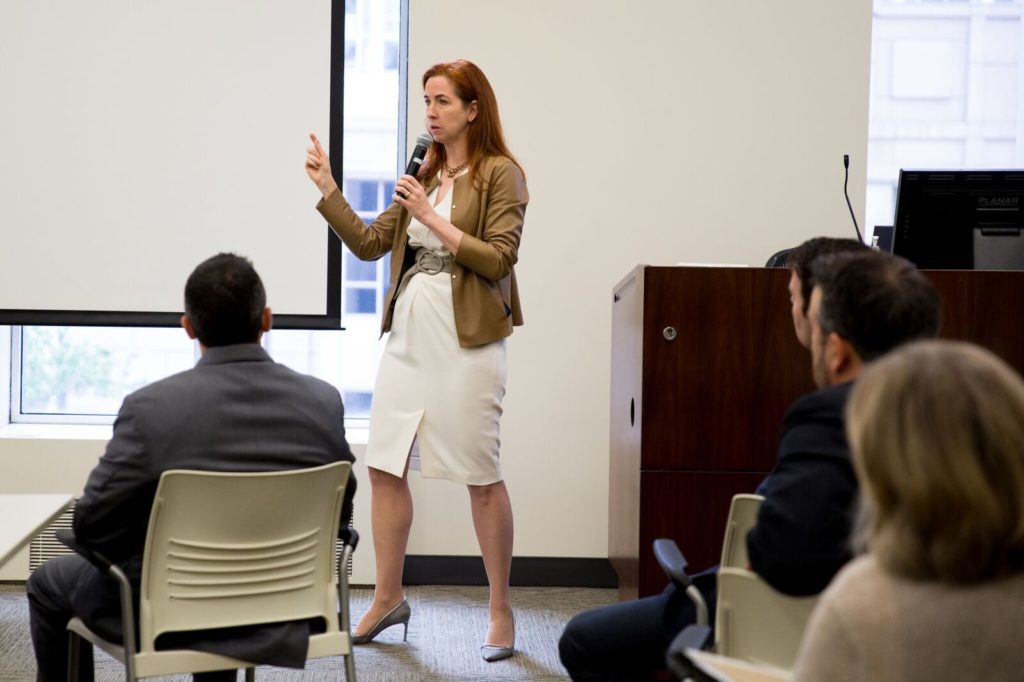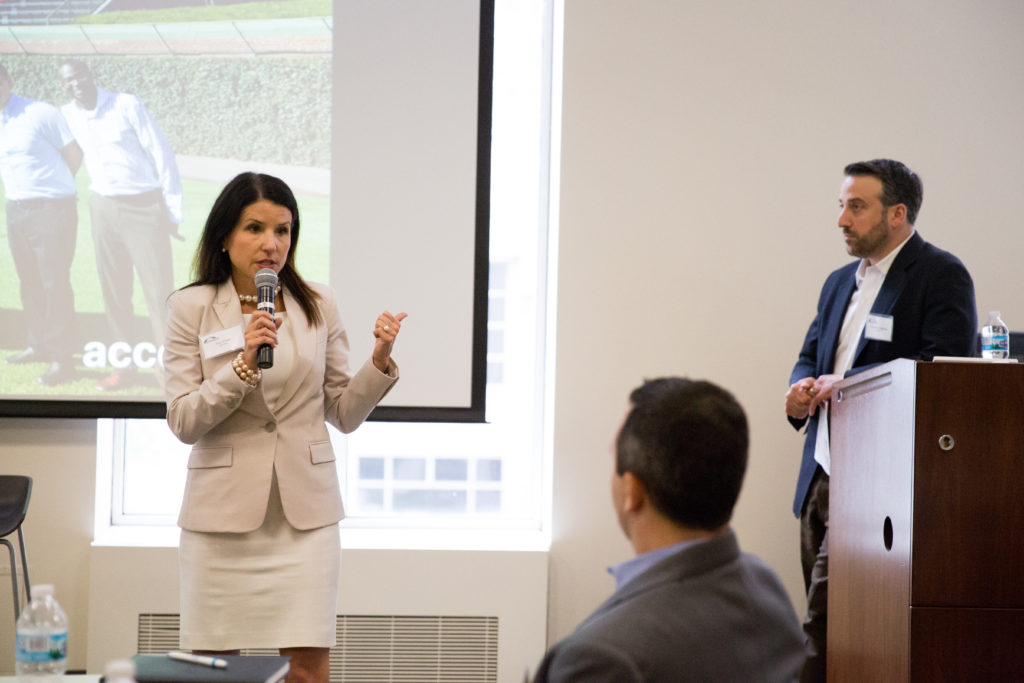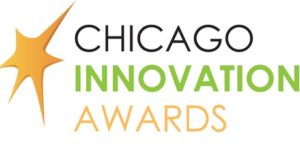On June 12th, the Illinois Science & Technology Institute (ISTI) and NIU’s Education Systems Center hosted our 2nd STEM Employer Summit focused on STEM talent pipeline development and building effective learning partnerships in Illinois. Employers and stakeholders discussed best practices for impactful talent development models through K-20 mentorship, internships, and college apprenticeships. Speakers shared their experiences, insights, and lessons learned including representatives from: Accenture, Aon, Apple, Blue Cross & Blue Shield of Illinois, Caterpillar, Edelman, Horizon Pharma, i.c. stars, Lurie Children’s Hospital of Chicago, Microsoft, Randstad US, Takeda Pharmaceuticals, and Year Up.
In this issue of Catalyst, we recap STEM development leadership and highlight key takeaways from our Summit panelists/presentations.
After a welcome from Shelley Stern Grach, ISTC/I Chair and Director of Civic Engagement at Microsoft, and an overview of the STEM talent landscape in Illinois from ISTC/I President & CEO Mark Harris, the opening session featured presentations from employers who shared education models achieving success across the talent pipeline. This included presentations from Olga Gutierrez, Strategic Initiatives Manager at Apple, Daaron Dohler, Operations Lead, R&D Strategic and Professional Affairs at Takeda Pharmaceuticals, Maria Rivera, Workforce Development Manager, Lurie Children’s Hospital of Chicago, Bridget Gainer, Vice President of Global Public Affairs at Aon, and Sam Melchiori, Solutions Strategy Manager at Caterpillar. Key insights ordered by presentation, included:
“We must challenge the racism of low expectations”
– Bridget Gainer, Aon
Learning By Doing
- Earlier exposure to STEM is critical to STEM talent development. Apple’s Everyone Can Code initiative targeting middle school students increases return on investment, cultivates lifelong coding skills regardless of career path, and tracks STEM interests in students over time.
- Mentorship amplifies STEM interest. Through our STEM Challenge Program and Mentor Matching Engine, Takeda challenged four Illinois high schools to solve real-world, complex problems within the pharma industry. Our post-STEM Challenge survey found 85% of students wanted to pursue STEM after high school and the experience working with professional mentors led to new lines of sight to careers and pathways in STEM fields.
- Work-based learning and talent partnerships between educational, corporate, and municipal stakeholders leads to dynamic STEM employment opportunities and increases employee retention. Aon’s apprenticeship program with Harold Washington College allows students to earn a competitive salary while completing Associate’s Degree requirements. In conjunction with Human Resources, they re-evaluated what “qualified” means. Apprentices show their ingenuity, intelligence, and work ethic given the opportunity.
- Similarly, CAT & UIC’s Innovation Lab collaboration has allowed CAT to rebrand and attract millennial talent while giving students complex problems to solve outside the classroom.
“Our apprentices didn’t just help another person get through… they kicked the door down!”
– Michael Chiappetta, Accenture
Creating new career pathways by including non-traditional hires allow new talent pools to emerge. Industry leaders Mike Chiappetta, Director of Chicago Market Development at Accenture, and Traci Fiatte, CEO of Professional and Commercial Staffing at Randstad US discussed their success using an apprenticeship model of employment and how hiring dynamics are shifting. By recruiting City Colleges of Chicago students, One Million Degrees, and Year Up Chicago interns, Accenture and a consortia of Chicago-area companies plan for hundreds of apprenticeships in 2018-19. Business input in educational curriculum and well-trained talent from non-profit/educational partners has led to new benchmarks in corporate employee retention.
Employees represent a corporation’s brand, mission, and purpose. Therefore, input for philanthropy and corporate social responsibility efforts must have investment from the staff. A fireside chat between Alissa Schepisi, Senior Vice President for Employee Experience at Edelman and Holly Copeland, Director of Public Affairs and Corporate Social Responsibility at Horizon Pharma, included sharing wisdom in sourcing the best CSR campaign, galvanizing employee involvement, and archiving philanthropic opportunities. Here are action steps any company can take ordered by presentation:
- Leverage your company’s mission to guide which corporate social responsibility campaign is best. Horizon Pharma’s focus on improving patients’ lives translates to supporting holistic care efforts.
- Survey employee interests to receive feedback on nonprofits and philanthropic efforts in the neighborhood.
- Depth trumps breadth. Horizon Pharma’s adoption of Perspectives High School has lead to ISTI STEM Challenge success, holiday giving for students’ entire family, and a familial alliance with the school’s surrounding community.
“Diversity isn’t a nice to have, it’s a must have.”
– Sandy Kastrul, i.c. stars
Unfortunately, disparities in STEM education accessibility exists statewide. Recent data from our STEM Talent Index found Illinois trails the national average for the share of STEM degrees awarded to female, Hispanic or Latino, and African-American students. Moderated by Audra Jenkins, Chief Diversity and Inclusion Officer of Randstad North America, a panel featuring Matt Blakely, Inclusion, Diversity, and Outreach Director of Motorola Solutions and Executive Director of Motorola Solutions Foundation, Jack Crowe, Executive Director of Year Up, Sandee Kastrul, President and Co-Founder of i.c. stars, and Bernadette Rasmussen, DSVP, Enterprise Services, at Blue Cross & Blue Shield of Illinois discussed using data driven approaches for addressing the gaps for women, people of color, and other under-represented groups in STEM fields. Panelist highlights include innovative methods employers can expand, retain, and develop STEM field diversity:
STEM Talent Expansion:
- Various IT and technology sectors do not require a four-year degree. Human resources and talent trainers can rethink the metrics of qualification to expand talent recruitment.
- Non-profits like i.c. stars and other bootcamps are training candidates based on employer needs, equipping individuals with limited experience the necessary skills to succeed on the job.
- Internships are a consistent avenue to increase STEM exposure to underrepresented groups.
- It’s OK to recognize the lack of cultural competencies internally. Seek out a “diversity coach” within your company to help with your blind spots. Diversity coaching and unconscious bias training for decision makers helps leadership to prioritize inclusion efforts
Talent Retention & Development
- Employee resource groups create camaraderie in the workplace and help new employees feel supported.
- Include diverse team members in the new hire process. Further, allow employee resource groups to recruit on the company’s behalf.
- “Underserved” and “underrepresented” often get lumped together. Diversity shouldn’t be about hitting numbers but truly investing in underserved individuals who want to work hard and need that opportunity/chance.
Thank you to all of our sponsors and participants who joined us for this important topic. To learn more about how you can help mentor the next generation of STEM innovators, visit us here. For additional information about the Chicago Apprenticeship Network, please contact Mike Chiappetta.
CHICAGO INNOVATION AWARDS NOMINATIONS
Nominate a company for the Chicago Innovation Awards! We invite the ISTC community to nominate the most innovative new products and services in the region for the next cycle of this prestigious honor. Deadline to nominate: 7/31.
WHAT WE’RE READING:
- Elon Musk company to build Chicago-to-O’Hare express transport [WGN-9]
- Sheryl Sandberg to announce Facebook training program in Chicago [Crain’s Business Chicago]
- Here are this year’s Fast 50 companies [Crain’s Business Chicago]
- UI led Discovery Partners Institute officially off and running [News-Gazette]
- Bay Area companies like Chicago more than you think [Crain’s Business Chicago]
- Amazon is selling facial recognition to law enforcement – for a fistful of dollars [Chicago Tribune]
- GOP mega-donor: I won’t write any more checks until DACA is fixed [The Hill]
- This map shows were students can find computer science programs in Chicago [Chicago Inno]
- Tech roundup: Boring infrastructure stuff, Facebook’s boot camp, and more [Built In Chicago]
- Emanuel: Amazon ‘really likes’ two Chicago sites [Chicago Tribune]




